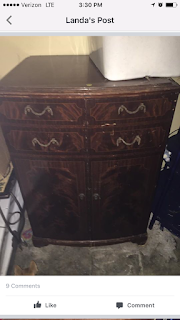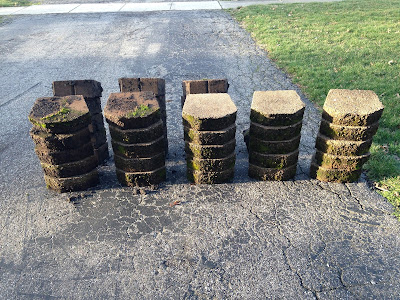background
Wednesday, August 9, 2017
Wednesday, March 8, 2017
Easy Sidewalk Makeover
If it’s a sunny day in Indiana, it’s almost guaranteed that you’ll see my husband and I tooling about the yard. Whether we’re starting a big project or simply picking up fallen sticks, we’re sure to be out and about.
When we bought our home nearly four years ago, the yard was by far the biggest eyesore. Visit the posts on koi pond removal, shed renovation or patio flip to see what I mean. (And please excuse some missing photos. Blogger no longer uses Picasa to host photos and when switching to Google many of the images were lost 😥).
The yard itself was sparse, stringy and uneven but I’ll leave that for another post. The biggest eyesore, at least from the road, was our driveway and sidewalk.
(Pause… if anyone knows how to request an updated Google street view of a home/street PLEASE MESSAGE ME NOW!)
You can see that update here, but before we were able to pull the trigger on that, we had to do some prep work.
Subject A:
These landscaping rocks were likely nice back in their prime. Years of moisture and shade allowed them to become discolored and drab and power washing wasn’t doing them justice. Since we were replacing our sidewalk anyway, removing them seemed like a good idea.
Now you’re probably wondering why I would waste an entire blog post talking about the removal of landscaping rocks. This again, is a gentle reminder that one man’s trash is another man’s treasure.
I sold these stones to some folks via Facebook garage sale. When they picked them up and told me what they intended to do with them, I felt was delighted to hear that they were going to live another purposeful life and not join the troves of reusable treasures at the landfill. One lady was using them to line the bottom of her fire pit while another was using them to build a fire pit. Awesome.
Oh, and I did make a quick buck (I think something like $20-$30), much to the surprise of my husband who is still dumbfounded at what people buy.
With that, I’ll challenge you… what trash of yours is another man’s treasure?
Thanks for stopping by the Humble Hammock!
Cara
Sunday, December 18, 2016
DIY: Necklace Makeover
I bought this adorable, snake-skin collar necklace from Kohls a few years ago. Like most accessories, it began to show wear and the glue from the snake skin began to peel off.
Rather than throw it away, I decided to attempt to re-skin it with some new material. I bought a roll of sticky drawer liner from Target (yep, for $2), and cut it to fit by tracing the old snake-sin pieces.
I then peeled the back of my cutouts and stuck them to the necklace!
Thanks for stopping by the Humble Hammock!
Cara
Friday, July 29, 2016
Before & After Driveway Rehab
For those of you out there who own a home - power to you! Owning a home is far more work than just lawn mowing and cleaning. You break things, other things break on their own; then you either shell out money to fix them or pay to have them fixed.
When we became home owners we knew that our driveway was going to need replaced. We wanted to make the improvement fast so that we could enjoy it (if) before we ever moved.
WARNING: this photo is graphic and is only intended for mature audiences.
(haha, okay, but really... :\ )
Beyond being visually unappealing, we couldn't get through winter without shoveling chunks of asphalt into our yard. We regularly tracked our driveway into our kitchen on our shoes and we had to sweep our garage of rocks.
We finally got tired of it (after we had saved enough money) and called D&M Concrete based out of Greenwood, Ind. They weren't our first call, but they were the only concrete contractor to give us the time of day AND a reasonable quote.
We booked them in the fall of 2015 and by March of 2016 they had broken ground and laid a new driveway and sidewalk in roughly two days.
Check out their progress....
We also had D&M put in a new sidewalk and install the first two feet of our garage floor (due to pitting).
These images were taken as soon as the framing was pulled off - WOW!!
And now - the stunning end product!
THREE WEEKS (yes, it really felt that long) later we were able to remove the "do not drive" tape. This meant we could finally park in our garage again AND use the driveway. We're much happier with our new curb appeal and love the functionality!
Some tips for those looking to redo their driveway:
- Get more than one quote! We originally thought we would do asphalt because people kept telling us that it was cheaper than concrete. "People" were very wrong. The price fluctuates (much like gasoline) and you should do your homework!
- If your contractor wants money before they do any work challenge them. A great contractor won't need money up front. They'll make sure it's perfect and your happy before they take your money. Besides, you want the job done, right?
- Have the contractor over and walk through your plans. Have them draw it out and review those plans again before they start the work. Over communicate to be sure that you're getting EXACTLY what you want. It's a pricey mistake if they get it wrong.
- Be flexible when it comes time for the work to happen. Weather is a huge factor when it comes to pouring concrete and sometimes your job will be bumped up or pushed back. Spring is a great time to have a job like this done because (hopefully) the only elements you're battling are rain - at least in Indiana. Freezing temps require additives to the concrete that jack up the price $1-$10 per yard!
- Prepare for a project like this at least 1-2 seasons in advance. Contractors schedule their jobs pretty far out so you'll want to be having these conversations before the moment you want the job done.
- Be honest with your contractor and share not only your budget but where you're hoping to save costs. They'll be able to tell you whether or not pouring more items, like a sidewalk, may actually be cost effective for you based on the mixing quantity of the cement truck.
- Review your contract and be comfortable with the terms. Add an addendum or initial changes in the document if you have reservations. This is particularly true for those wanting cash in advance of the job.
- Get educated on your new concrete or asphalt and learn about it's care. Concrete for example requires a spray on sealant every 2-3 years. It's also not good to power wash it but rather to use bleach to kill the fungi and bacteria growing on it and gently power wash it off afterwards.
Thanks for stopping by the Humble Hammock!
Cara
Tuesday, July 26, 2016
DIY: Plant Stand Makeover
Thrifting is all about the hunt. Truth be told, I've spent a couple of years looking for a specific item. Sure, I could go purchase it new from a big box store or even look on eBay, but the reality is that the hunt is more exciting than finding the item. Sometimes I even find what I'm looking for and decide to be picky and pass that particular product over to find one in better shape.
This spring I took my mom antiquing, or "teeking" as my grandmother calls it. It's something that we both enjoy and it's a good excuse to spend some quality time together. While out and about in some unchartered teeking territory, we came upon not only a humble little shop, but a honey hole of inexpensive and unique items.
The only find I'm going to blabber on about today is this $7 plant stand. It was handmade by some form of carpenter, who knows how long ago. I was immediately drawn to the size (which would pair well with a taller stand and a ground-level pot) and the fun shape.
It doesn't take a rocket scientist to see that all this little gem needed was a fresh coat of paint and new home. Both are things that I happen to be able to provide.
I made quick stop in the paint aisle during my subsequent home store trip and picked up this $3 can of shiny gold paint. Then I zipped home and ran the grittiest sandpaper I could find over the stand.
Within ten minutes I took this stand from 1970 to 2016 and I couldn't be happier with the end result!
Thanks for stopping by the Humble Hammock! Be sure to follow this page or bookmark it in your browser for more great DIY inspiration later!
Friday, July 22, 2016
DIY: Staining Furniture
Thanks for sticking with me through part two of my furniture overhaul! I know in the last post I focused heavily on the curio cabinet, but today I'm going to show how I stained my accompanying tables and then reveal the finished camera holder.
As I mentioned, the curio cabinet was made of pine wood. The end tables were already cherry. Since I wanted the two to match it was easier to use a red/cherry stain on the cabinet versus trying to dull down the redness of the tables.
Miniwax (found at your local Lowes / Home Depot) makes some great stain that enhances the quality of the wood without looking overly waxy/finished. I did my due diligence and scoured the internet for feedback on how to match pine to cherry and landed here. I'm very happy with the result but I'll leave it to you to determine how well it worked.
I started by adding one coat of stain to the tables and leaving it on for five minutes before wiping away the unabsorbed stain. I didn't want the tables to be much darker than they already were so the less time the better. I then took the bottom side of one of the curio cabinet shelves and tested (in five minute increments) how long it would take to get the closest color match. The result - 20 minutes!
Here's a half and half of the table progress. Talk about instant gratification!
This is the color difference between a stripped pine shelf and one being stained (before excess was wiped).
And now... the end result(s)! The staining took a bit longer (~1 week) with application AND dry time. I did this during the summer months (in humid Indiana) and it remained tacky longer than I'd hoped.
*More on my fabulous lamps at another time.
Saturday, July 16, 2016
DIY: Stripping Furniture
In due time I'll write a blog post about my Brownie Camera Collection and the hunt that continually ensues. Until then, I'll tell you that I've been looking for a curio cabinet for these beautiful cameras for nearly a decade.
Most of my friends have heard about my infatuation with Facebook's garage sale groups. I've alluded to them before. I rarely purchase items but I'm always on the prowl for very specific items.
I found this cabinet *yes, this is a screen shot from my phone* and knew right away that the scalloped portion on top would pair nicely with a pair of vintage end tables my mother gave me. The going price was $75, but I managed to talk the seller down to $60. There was a loose leg and the glass was popped out on one side, but I had faith in myself and my husband's tool box.
Pine can be stained to match other woods fairly easily as it has a neutral undertone and can be tinted to match woods with stronger hues. So off I went to strip this pine cabinet and ultimately tint it to match my cherry end tables.
For those of you who have never stripped furniture I recommend pulling the item completely apart so that you can move quickly once you get the stripping process started. Be sure to make room for the wood to dry (standing up) and invest in some thick rubber gloves (I use elbow-high dishwashing gloves from the local grocery). I also like to do the stripping over a drop cloth or trash can to mitigate extra mess.
Citristrip (sold at Home Depot) is one of my favorite stripping agents. It costs less than $20 and will last through multiple pieces of furniture. It's orange based unlike many of the harsh chemical based strippers. The smell is far less overpowering, but don't be fooled - it still packs a tough strip. When using this product I pair it with:
- blue shop towels
- a stripping tool
- old plastic cup and sponge
- elbow-length rubber gloves
To strip:
- Slip on your rubber gloves
- Pour some Citristrip into the old cup and add the sponge
- Glob the product onto the wood with the sponge and begin scrubbing/rubbing onto the wood
At this point the wood will begin to appear watery as the stain/top coat loosens. Keep working the sponge and breaking loose the old covering. If it becomes tacky you'll need to add more Citristrip and keep it moving. DON'T TRY SCRAPING IF IT'S TACKY. You will easily damage the grain of the wood.
Don't cut corners like I did in these photos. These gloves were leaking Citristrip and caused my hands to peel for more than a week. Don't do this to yourself...
Once the watery top coat is covering the top of the wood, grab your scraper tool and begin to apply pressure and push the solution to the top of the tool before wiping in your shop towel. See the demonstration below...
This is going to be a longer process for pieces with multiple layers of sealant or paint. Be prepared to take your time on each piece to do a quality job before moving on to the next piece. If the wood appears "shiny" after the top coat has been removed there is still remaining topcoat. You may need to repeat steps 2-3 times to see results.
Here's my before and after progress!
And here is the stripped cabinet! This cabinet had one layer of a light stain and came off fairly easily. I had the cabinet and shelves stripped in just a couple of hours.
Subscribe to:
Posts (Atom)















































